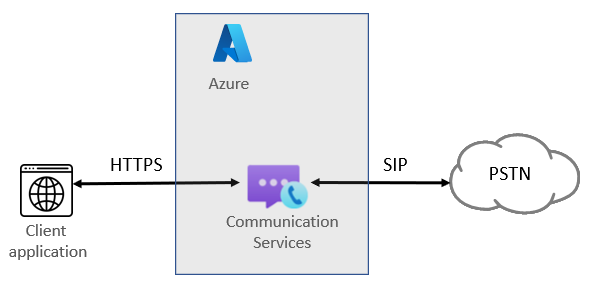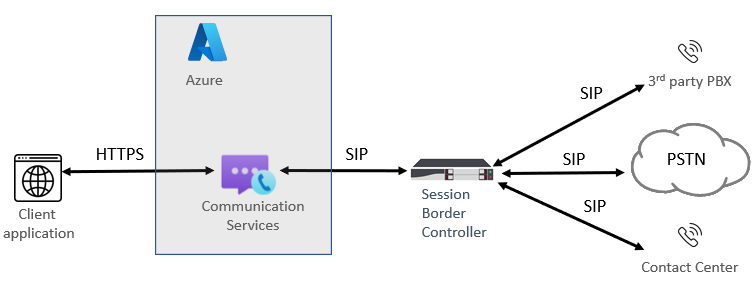Note
Access to this page requires authorization. You can try signing in or changing directories.
Access to this page requires authorization. You can try changing directories.
Important
SMS and PSTN capabilities depend on the phone number you use and the country/region that you're operating within as determined by your Azure billing address. For more information, visit the Subscription eligibility documentation.
Azure Communication Services Calling SDKs enable you to add telephony and Public Switched Telephone Network (PSTN) access to your applications. This page summarizes key telephony concepts and capabilities. See the calling library to learn more about specific SDK languages and capabilities.
Telephony overview
Whenever your users interact with a traditional telephone number, the Public Switched Telephone Network (PSTN) voice calling handles the call. To make and receive PSTN calls, you need to add telephony capabilities to your Azure Communication Services resource. In this case, signaling and media use a combination of IP-based and PSTN-based technologies to connect your users. Communication Services provides two discrete ways to reach the PSTN network: Voice Calling (PSTN) and Azure direct routing.
Voice Calling (PSTN)
An easy way of adding PSTN connectivity to your app or service, in such case, Microsoft is your telco provider. You can buy numbers directly from Microsoft. Azure Cloud Calling is an all-in-the-cloud telephony solution for Communication Services. It's the simplest option that connects Communication Services to the Public Switched Telephone Network (PSTN) to enable calls to landlines and mobile phones worldwide. Microsoft acts as your PSTN carrier, as shown in the following diagram:

If you answer yes to the following questions, then Voice Calling (PSTN) is the right solution for you:
- Voice Calling (PSTN) is available in your region.
- You don't need to retain your current PSTN carrier.
- You want to use Microsoft-managed access to the PSTN.
With this option:
You get numbers directly from Microsoft and can call phones around the world.
You don't need to deploy or maintain any on-premises system because Voice Calling (PSTN) operates through Azure Communication Services.
Note
If necessary, you can connect a supported Session Border Controller (SBC) through Azure Communication Services direct routing for interoperability with third-party private branch exchanges (PBXs). SBCs can also enable analog devices and other third-party telephony equipment supported by the SBC.
This option requires an uninterrupted connection to Azure Communication Services.
For cloud calling, outbound calls are billed at per-minute rates depending on the target country/region. See the current rate list for PSTN calls.
Azure direct routing
With this option, you can connect legacy on-premises telephony and your carrier of choice to Azure Communication Services. It provides PSTN calling capabilities to your Communication Services application even if Voice Calling (PSTN) is not available in your country/region.

If you answer yes to any of the following questions, then Azure direct routing is the right solution for you:
- You want to use Azure Communication Services with PSTN calling capabilities.
- You need to retain your current PSTN carrier.
- You want to mix routing, with some calls going through Voice Calling (PSTN) and some through your carrier.
- You need to interoperate with third-party PBXs and/or equipment such as overhead pagers, analog devices, and so on.
With this option:
- You connect your own supported SBC to Azure Communication Services without the need for extra on-premises software.
- You can use literally any telephony carrier with Communication Services.
- You can choose to configure and manage this option, or have it configured and managed by your carrier or partner. Ask if your carrier or partner provides this option.
- You can configure interoperability between your telephony equipment, such as a third-party PBX and analog devices, and Azure Communication Services.
This option requires:
- Uninterrupted connection to Azure.
- Deploying and maintaining a supported SBC.
- A contract with a third-party carrier. Unless deployed as an option to provide a connection to third-party PBX, analog devices, or other telephony equipment for users who are on Communication Services.
Next steps
Conceptual documentation
- Phone number types in Azure Communication Services.
- Plan for Azure direct routing.
- Session Border Controllers certified for Azure Communication Services direct routing.
- Pricing.
- Learn about call automation API that enables you to build server-based calling workflows that controls and manages calls for phone numbers and direct routing.
- Number lookup overview.
- Try Phone Calling.